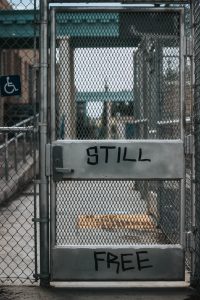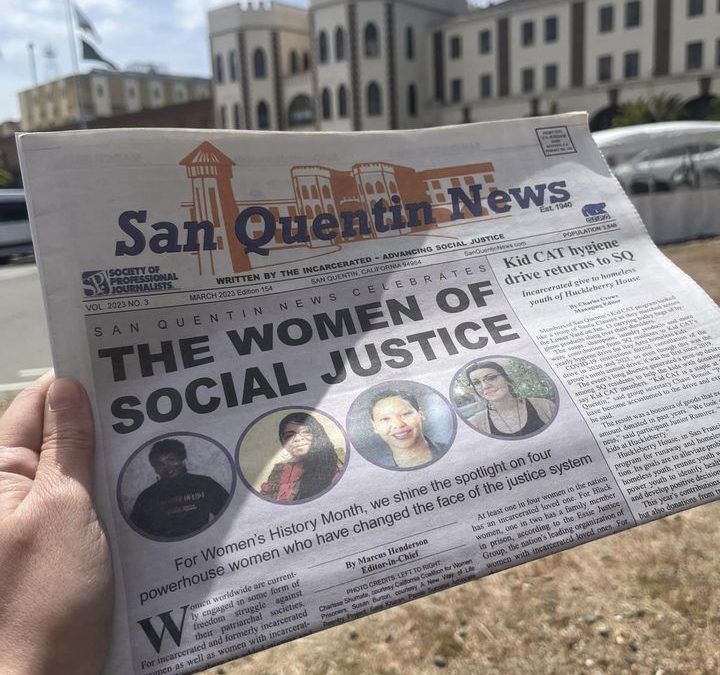
Freedom and prison: two opposites. How can you be free behind bars? At San Quentin State Prison north of San Francisco, they seek their freedom of thought.
This is my first visit to a prison. At the entrance they warn us: “If you hear shots, don’t run, we know how to protect you.” There are nearly 4,000 inmates, only men. The dress code for visitors is black, and phones are prohibited. First stop is the church. We are greeted by a man – a murderer. He committed the crime at 18. He is sorry and writes letters often to the family of the victim. He promised his mother on her deathbed that he would make amends. He talks about redemption and is humble.

We enter the hospital. A room with eight metal cages but also pink paper hearts hanging from the ceiling – what a contrast. Here they hold group and individual sessions, to talk about their emotions. The Division of Rehabilitative Programs says that its mission is to help reintegrate the people in their care back to their communities with the tools to be drug-free, healthy, and employable members of society by providing education, treatment, and rehabilitative and restorative justice programs. It wants all inmates to think about their future release from prison.
Out in the yard, prisoners are running, playing basketball, and listening to music. “Do you see the basketball court – there the African Americans gather. On that bench, the whites, and next to them the Mexicans,” a prisoner tells us. “Is this the prison distribution?” we ask. “No, those are the unwritten rules.” At that moment the prisoner turns to me: “What did you expect to see here?” I am surprised. A second of silence. I answer: “Very angry people – that’s what I expected to see.” He smiles and says: “We’re not that bad.”
We enter a room where newspapers hang on the walls and books are arranged on the shelves. Inmates are preparing the next newspaper. It is written by prisoners without access to the Internet. Today, San Quentin News prints 35,000 newspapers each month and distributes them to all 30-plus prisons in the California Department of Corrections and Rehabilitation, four juvenile facilities, and university and public libraries, plus hundreds of donors. It publishes the quarterly magazine Wall City, the newsletter Inside SQ News and the website sanquentinnews.com. The paper is funded by grants from foundations and generous private donations.
Prisoners didn’t study journalism beyond some courses in prison, but they practice it with passion. In the next room they are editing videos. Are they critical of the prison administration? Yes, sometimes they write critical articles about the food in jail. Here is some freedom in prison, freedom of speech. Before we leave, they give us each a newspaper as a souvenir.

Time to see where they sleep. Many cells are about 6 by 8 feet with a bunk bed and a toilet. That is all. At this point the alarm goes off. All the prisoners squat. The security started running. Something is going on. We never understood what. They got us out quickly.
In newer quarters, the cells are about 9 feet by 9 feet with only one occupant. We stop, and a man who received 259 years in prison talks to us. They gave him the last 50 years or so because he tried to escape. The prisoner admits: “They are smart, there are cases of suicides.” And in tense situations, the guards intervene: first verbally and only then physically with batons or pepper sprays.
What do the numbers say about crime in California? A report from that state’s Department of Justice shows this for 2021 (https://data openjustice.doj.ca.gov/sites/default/files/202208/Crime%20In%20CA%202021_0.pdf): The violent crime rate increased 6.7 percent, the property crime rate increased 3.0 percent, the homicide rate increased 9.1 percent, the burglary rate decreased 5.3 percent, the rape rate increased 8.6 percent, and the motor vehicle theft rate increased 8.2 percent.
Last stop: the canteen. Beautiful murals cover the walls. They were painted by a prisoner in the 1950s using only one color, red. Authorities did not allow him another, so that he could not stain his clothes, fool the prison guards and try to escape.

We’re leaving. The prisoner who was escorting us out holds out his hand to say “goodbye.” I shake the hand of the man who killed the people who raped a 6-year-old child. He tells me that he hopes that the image of prisoners in my mind will be different from “monsters” after this tour of the prison. I ask myself, is it possible for a person to change? An old proverb says: “The wolf changes its coat, but not its character.” Yet after five hours in prison, I come out with new pictures – not on my phone, but in my mind – about life after the mistake.

